Digging For FishiesPaleontologists Uncover a Trove of Ancient Fossils That Give Insights Into Antarctica as an Evolutionary CruciblePosted June 17, 2019
The mountains of Antarctica may seem an unlikely place to find fish, but they were exactly what a team of paleontologists working along the edge of the Polar Plateau last winter were looking for. 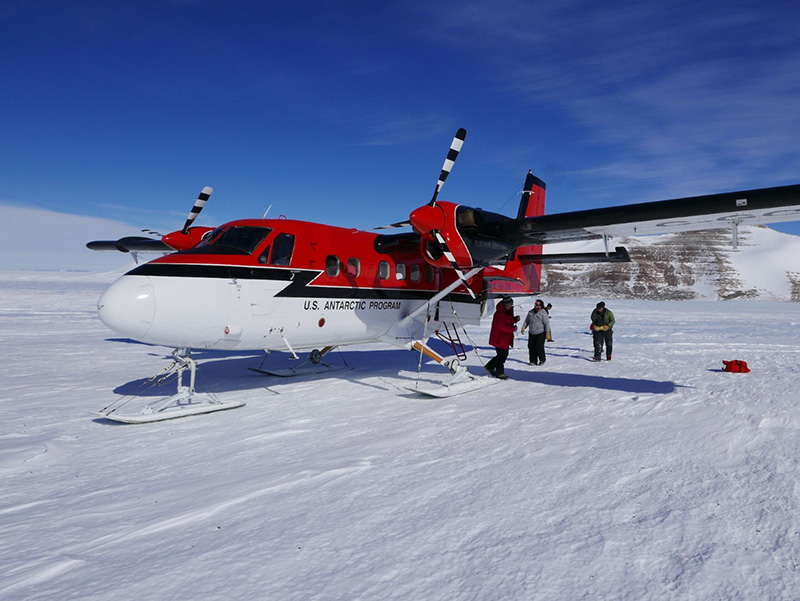
Photo Credit: Ted Daeschler
Landing at Deception Glacier in a Twin Otter plane on a reconnaissance flight, the team scoped out a campsite.
In a region now defined by dry rocky terrain poking up through vast sheets of thick ice, the five-member team spent much of December and January scouring the exposed landscape for the remains of ancient fish. After bone hunting for a month, they returned from the field with a trove of fossils that were laid down (deposited) at a time when the continent was much warmer and wetter than today. Then, before continental drift shifted its location poleward, Antarctica was farther north, likely about the latitudes where Australia is today. The continent was ice-free and teeming with life. Primitive sharks and fish swam through its rivers and streams while some of the earliest shrubs and land plants covered its surface. And it was the site of an explosion of biodiversity and evolutionary adaptation. "What we're after with this project is understanding evolution's 'Big Bang' of fish," said Neil Shubin, a paleontologist at the University of Chicago and principal investigator on the project. "When you think about what happened about 400 to 390 million years ago, you had the origin and early evolution of some of the major groups of fishes as we know them… So we targeted these rocks." The research is supported by the National Science Foundation, which manages the U.S. Antarctic Program. 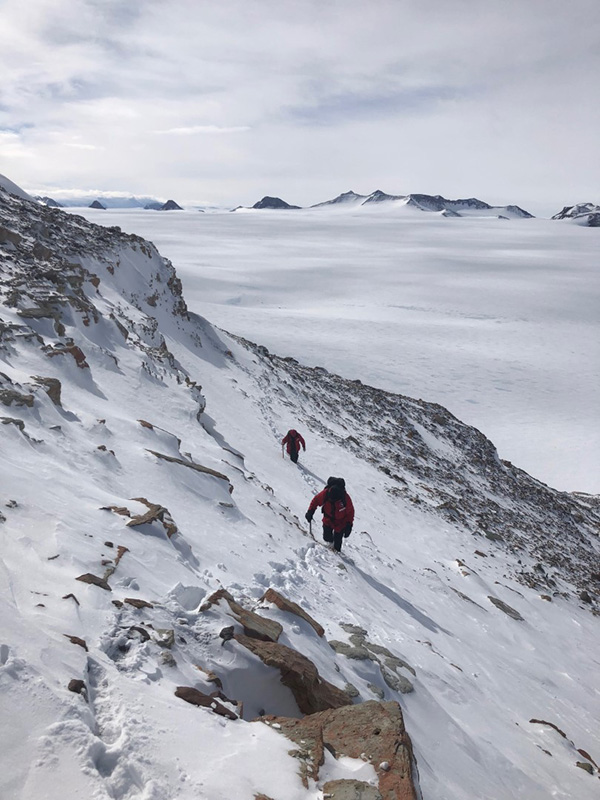
Photo Credit: Ted Daeschler
Members of the team climb along the slope of Mount Ritchey through recently-fallen snow.
The team set up camp at the foot of Mount Ritchie, beyond the southern end of the McMurdo Dry Valleys, a perpetually ice-fee region of the continent, to scour a geologic formation called the Aztec Siltstone. From there, they traveled to a number of nearby rocky outcroppings part of the widespread geologic formation formed millions of years ago in prehistoric bodies of water. "It's a whole package of layers of rocks that represent ancient streams and rivers and lakes. These are fine grain sediments that are prefect for fossils," Shubin said. "It's not like these rocks don't exist anywhere else in the world, but they don't exist to this degree of exposure. It gives us a really nice window." The area was littered with fossils and the team sent several hundred pounds of specimens back to their labs and the museum collection at the Academy of Natural Sciences in Philadelphia. They discovered a plethora of intact fossils from different species that inhabited the region as well as a number of rock layers densely packed with crushed fossil fragments. "Some of them were so loaded with bones that it was basically all bone and no rock," Shubin said. "It was just loaded with bones; bones from armored fish, bones from lobe-finned fish. Some of them are individual bones, some of them are jaws and some of them are skulls or parts of skulls. What was remarkable about this season was just the amount of bone we saw in the rocks." Paleontology on the Edge of the Polar Plateau"We targeted the Aztec [Siltstone] for a lot of reasons," Shubin said. "The number one reason is it's the right kind of rock to hold fish fossils of what we're looking for - sandstone, siltstone, shales, reflecting the environments that these creatures likely lived, in so the right kind of rock. The right age, about 390 million years old. And then given that they're in the Dry Valleys or in these nunataks [isolated peaks of rock projecting above the surface of the ice] near Deception Glacier they'd be exposed. You can see the rock they're not covered." 
Photo Credit: Corey Robinson
Neil Shubin (left) and Tim Senden examine specimens they pulled from a rocky outcrop.
This is the second expedition to the Antarctic Aztec Siltstone for the team. Two years ago, they worked a similar area and also returned with a sizable cache of fossilized bones. "Our first season we were up at the heads of the Dry Valleys so there were more rocky valleys, more rock ground to walk on, less glaciers and snow," said Ted Daeschler, a paleontologist at Drexel University in Philadelphia. Camping in the midst of the valleys gave them easy access to outcroppings and sites that were rich in preserved bone. The valleys also protected the areas from a lot of the bad weather in the region. "In the previous camps in the 2016/2017 season, we knew where we could go to look at the sections and find fossils. All walking. We could be out every day. We virtually were every day out digging and looking," said John Long, a paleontologist at Flinders University in Adelaide, Australia. "This camp involved waiting for good weather, and then some days we'd be working on the mountains looking at the fossil beds, other day we'd be making routes to the next sites." This past year, their camp and worksites were located farther south. It was actually situated atop the Deception Glacier, in a valley at the foot of Mount Ritchie which abuts the polar plateau, the vast barren ice sheet that covers most of the continent. 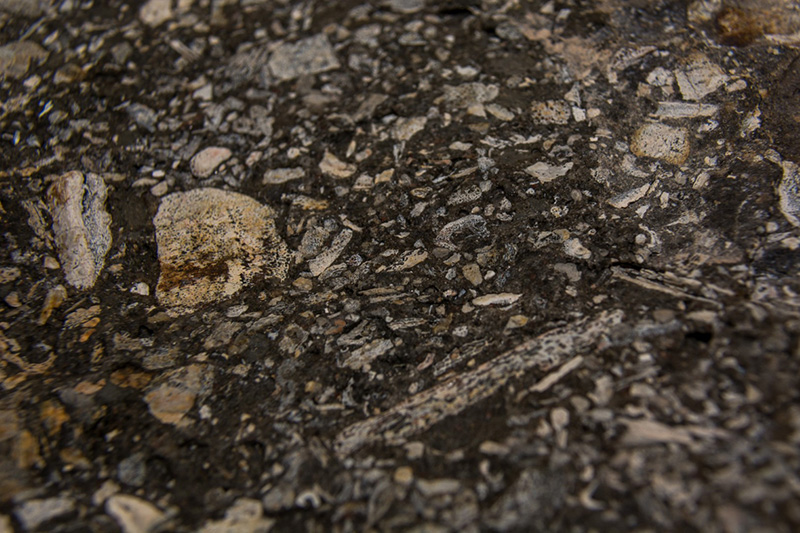
Photo Credit: Mike Lucibella
Many of the rocks the paleontology team recovered were chock full of crushed bone fragments.
"When we would go up out behind Mount Ritchie, you were staring straight out into the polar plateau," Long said. "There was a lot of wind, and a lot of dramatically cold temperatures." Those winds and weather made for difficult working conditions. In mid-December, right at the beginning of their field season, the team was hit with a particularly badly-timed storm. "The first week was all snow. All snow all the time, which kind of doesn’t work on a lot of levels," Shubin said. "Not only can't you work in it, but for several days you cannot productively work because the rocks are covered in snow." With the fossils they hoped to collect buried by snow, collection ground to a near halt. At the same time, the snow also prevented them from being able to safely scout out routes to worksites farther away. "Not only did it bury rock and make walking around more difficult," Daeschler said. "But our mountaineer, Forrest, he needed to learn the routes that we would take, and he couldn't see the ice as well. So that just slowed us down." 
Photo Credit: Ted Daeschler
Camped atop of Deception Glacier, the team would take snowmobiles to investigate nearby rock outcroppings.
As the weather improved, the team was able to start to visit more and more sites throughout the region. They used snowmobiles to travel to sites farther away and climbed up the sides of nearby Mount Ritchie. "We ended this season with 20 sites that we recorded and collected from, all in this Aztec Siltstone," Daeschler said. Though they had used satellite images to pick out the regions they wanted to visit, hunting for fossils is still a fundamentally low-tech process. At each site they would walk along across the area, keeping their eyes on the ground and systematically scanning the surface for anything that resembled a bone sticking out. When they spotted one, gingerly collected it still mostly encased in the rock it was embedded in. After carefully wrapping them, they shipped them back to the museum in Philadelphia and are just now starting to go through and analyze what they found. "We have quite a lot of skull material of different species, some of which could be new. We won't really know until we do the preparation analysis," Long said. "There will be a number of really solid good papers come out of the two field seasons, that's for sure." The Big Bang of FishShubin is hoping that the finds from these Antarctic seasons will add to his previous work. He is best known for the fossil of a creature called Tiktaalik roseae in the Canadian Arctic, a lobe-finned fish that roamed the primordial Earth about 375 million years ago. Though technically a fish, Tiktaalik was essentially a "missing link" between fish and amphibians, the first fish to evolve primitive legs eventually used for venturing onto land. It was covered in scales and had gills but also breathed through lungs and the bone structure in its fins resemble the arm and leg bones of all modern land-dwelling vertebrates. 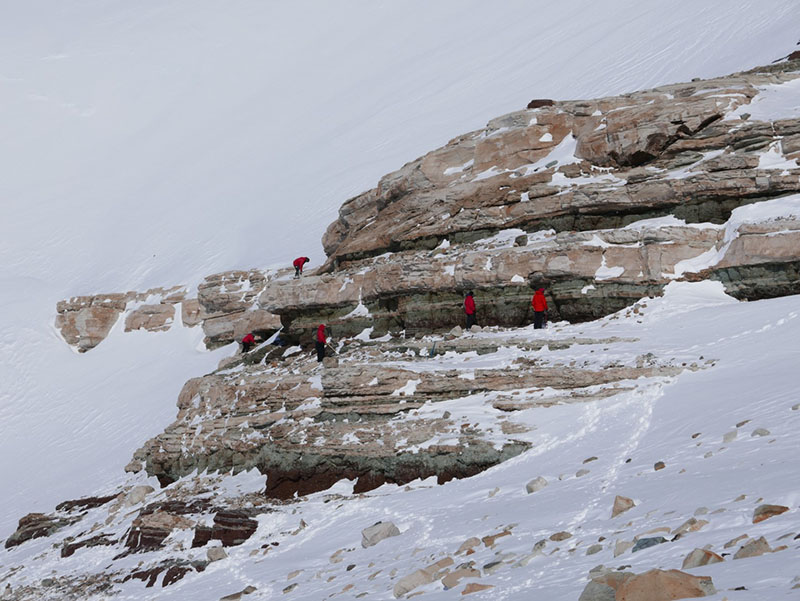
Photo Credit: Ted Daeschler
Team members climb over an exposed section of the Aztec Siltstone looking for fossils sticking out of the freshly-fallen snow.
Shubin's two Antarctic seasons focused on regions where the rocks are about 10 to 15 million years older and could yield fossils that they're hoping will shed light on the origins of the ancestors of Tiktaalik. "We designed it so it could be very complementary to the Tiktaalik expeditions," Shubin said. "With something like Tiktaalik, you have a fish with arm bones, a radius and ulna, and we want to know where do those come from? So were kind of looking deeper. So we see with Tiktaalik we saw that transition from fish to land living animals very beautifully, but …what's their root?" The Aztec Siltstone encompasses a critical point in Earth’s history during the Devonian period about 390 million years ago. Sometimes referred to as "the age of fish," the Devonian was a period of time that could offer insights into the origins of Tiktaalik and its relatives. "This slice of time, the middle Devonian to the late Devonian, is so consequential in the history of vertebrate animals," Daeschler said. "You're seeing the kind of diversification of groups that become abundant today whether it's the limbed animals or whether it's the sharks, or whether it's the ray-finned fish." The planet was in the midst of an explosion of evolutionary diversity amongst fish in the oceans and at the same time, plants and invertebrates were becoming firmly established on land. Tiktaalik and other early terrestrial pioneers were still several million years off, but the stage was set for them to emerge onto the scene. 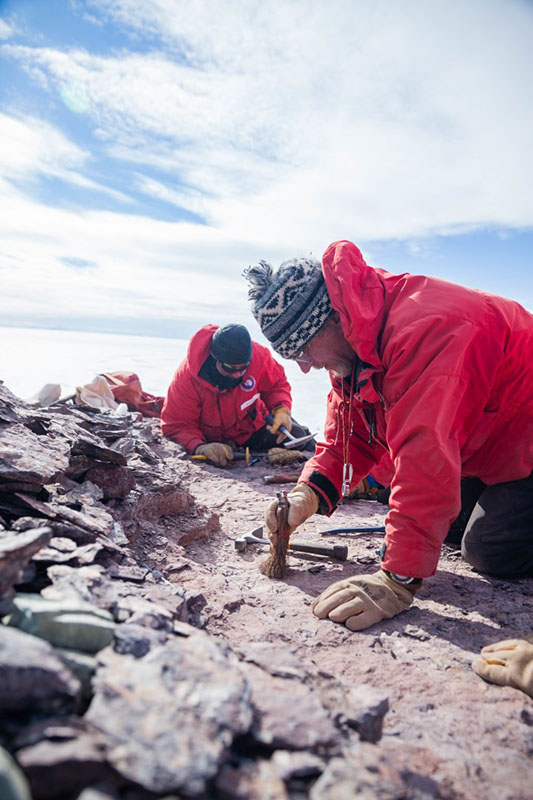
Photo Credit: Corey Robinson
John Long (foreground) and Neil Shubin dig into a section of exposed rock, hunting for fossils.
"You're seeing what kind of environments were the crucibles for evolution of those forms because it's the environment that is driving evolution basically, and the ecosystem around these animals," Daeschler said. The region that Shubin and his team visited, would have more closely resembled a verdant floodplain, rather than a barren ice sheet. "If you're standing on Deception glacier… you would be in an environment much like the Nile River Delta today," Shubin said. "That's kind of mind-blowing if you think about it. You're standing at Deception Glacier, and you seeing the glaciers and the crevasses and the sastrugi [wave-like ridges caused by winds on the surface of hard snow] and nunatak and it was an ancient delta." The specimens they found reflect that ancient environment. They include numerous different kinds of armored fish called placoderms, including a particularly large skull from a species called Bothriolepis mawsoni as well as numerous shark teeth, the remains of early lobe-finned fish which might be a primitive ancestor to Tiktaalik, and some ray-finned fish from a different evolutionary branch. Order from ChaosMaking sense of all the fossils they found is a big task that's now only just beginning. "The next challenge is actually going to be curation, cataloguing all that, which is great. It's wonderful work,” Daeschler said. The first step is to uncover and get a complete picture of the bones the team collected so they can be identified. Some will be done using traditional methods of meticulously chipping away the surrounding rock, or even using acids to dissolve it. They’re also using newer techniques to image bones still embedded within the rock. "A lot of this will be very high-tech analysis," Long said. "Incredibly sophisticated tools, not just CT scanners, everyone's got CT scanners, but synchrotron access and neutron beams. The neutron beam facility is brand new in Australia and it can like shoot through 30 centimeters of solid rock and image a pin in the middle with perfect clarity." CT scanners fire high-energy x-rays through the rock and the different densities of the embedded bones create an image. Synchrotron beams work similarly but with more intensity, while neutron beams fire high-energy neutrons through the samples. With these methods, the scientists can create detailed images of the embedded bone in a fraction of the time it takes to remove the surrounding rock. "This is the new way to do it," Daeschler said. "It's changed paleontology." As they physically and digitally uncover the underlying fossils, they’re starting to identify them as well. It's a slow, painstaking process. Up first are the ones that they think could yield the most insight into the ancient ecosystems and the development of early four-legged creatures. However ultimately, they plan to curate the collection well enough so that anyone interested in studying these prehistoric organisms in the future will also be able to find what they need. "We may not do it all in our lifetimes, that's the fun thing about collections," Daeschler said. "Each specimen will have a specimen number, it'll be cataloged, well publish on it, all that. There could be someone 25 years from now, 50 years from now, 300 years from now who will use this for additional questions and additional studies. I always like to point that out. It's not just us, and that's why curation in a museum is so important. That's kind of part of my role, is taking care of it, making it accessible." NSF-funded research in this story: Neil Shubin, University of Chicago, Award No. 1543367. |



For USAP Participants |
For The Public |
For Researchers and EducatorsContact UsU.S. National Science FoundationOffice of Polar Programs Geosciences Directorate 2415 Eisenhower Avenue, Suite W7100 Alexandria, VA 22314 Sign up for the NSF Office of Polar Programs newsletter and events. Feedback Form |



